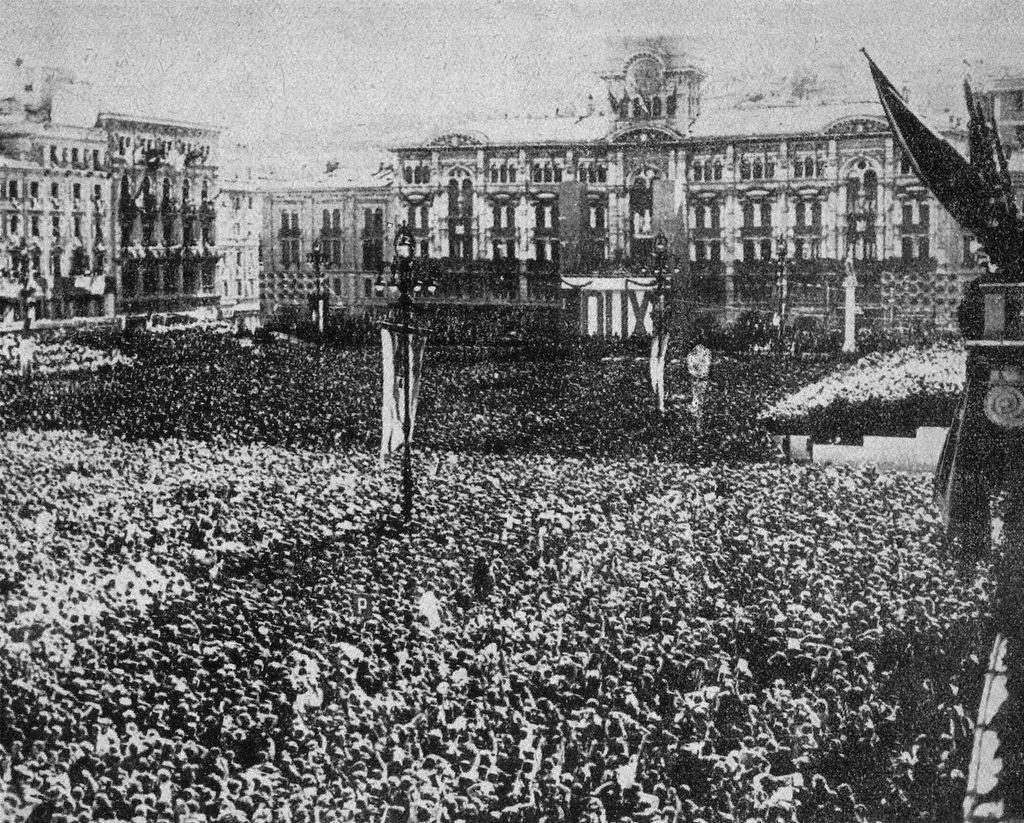Fascism
The development of fascism in Trieste was precocious and rapid. In May 1920 the first voluntary city defense squads were formed in the city, groups of fascist squads under the command of naval officer Ettore Benvenuti. On June 11, the daring of an assault regiment awaiting embarkation for Albania walked the central streets of the city praising the revolution and using weapons against the officers. Only late at night the insubordination returned, with a toll of two dead and several injured. Also in June, the headquarters of the Trieste student avant-garde, also clearly of fascist inspiration, was opened. In these organizations the squadrists were recruited who, on 13 July 1920, led by Francesco Giunta, set fire to the Hotel Balkan, during an anti-Slavic demonstration, called by the Trieste fascists, taking as a pretext the dead of the incidents in Split. During the riots, it was the squadristi themselves who set fire to the building, showing "[...] with the flames ... which can well be seen from different points of the city, the strength of awaiting fascism".
In December 1920, Fascism opened its own newspaper in the city, Il popolo di Trieste, which began to propagate the idea that the collapse of the decrepit and anachronistic Austro-Hungarian Empire finally offered the possibility, to Trieste and to Julians in general, to carry out a important function in the Adriatic and in the Balkans, in an imperialist key. Sensitive to this call were "industrialists in danger, bourgeois with an uncertain future, demobilized officers, restless students, ambitious commoners". The elections of 1921 saw in Trieste a notable affirmation of the fascist coalition (the Italian Bloc) which obtained about 45% of the total votes. It is therefore not surprising that, in the aftermath of the march on Rome (28 October 1922), the occupation of some public buildings in the city by local squadrists, led by Francesco Giunta, took place with the approval of the authorities. A few days later a procession of fascists marched through the streets of Trieste, accompanied by a unit of "fascist cavalry". The black twenty years had begun also for the Julian city. Following the flames, various explosions followed, probably due to a weapons depot in Balkan.
With the advent of fascism, a policy of denationalizing the so-called alien minorities was inaugurated in Trieste and Venezia Giulia. Starting from the mid-twenties, the Italianization of toponyms and surnames began, in 1929 teaching in Slovenian and other Slavic languages was definitively banned from all public schools of all levels and, little later, all Slovenian organizations were dissolved. The goal was to forcibly assimilate minority ethnic groups in contempt of their own culture and traditions. This policy, together with the anti-slave actions of the squads, often studded with dead and wounded, had very serious repercussions on the delicate inter-ethnic relations. The Slovenian separatist and terrorist organizations, including the TIGR and the Borba, reacted to the murders perpetrated by the fascists with equal brutality: acts of armed resistance multiplied and violent actions took place against members of the fascist regime and members of the police or, in some cases, even against ordinary citizens.
In 1930, two attacks by the TIGR took place in Trieste: the one on the Victory Lighthouse and, much more serious, the one on the editorial staff of Il Popolo di Trieste, which caused the death of the stenographer Guido Neri and the wounding of three people. The police authorities then proceeded to an extensive investigative action, eradicating the resistance cells: the accused (all Slovenes) of various crimes including - in addition to bomb attacks - also a series of murders, attempted murders and fires, were then tried by the Court special for the defense of the state (1926-1943) transferred for the occasion from Rome to Trieste (first trial in Trieste). The trial ended with an exemplary sentence: four defendants were given the death penalty (Ferdo Bidovec, Fran Marušič, Zvonimir Miloš and Alojzij Valenčič) and were shot in Basovizza on 6 September 1930, twelve others were given various variable prison terms in two years and six months and thirty years. Two were acquitted.
In December 1941, once the war had already begun, a second trial by the Special Court for the Defense of the State was held, again in Trieste, against nine members of the TIGR (Slovenes and Croats) who were accused of terrorism and espionage. Five of them (Pinko Tomažič, Viktor Bobek, Ivan Ivančič, Simon Kos and Ivan Vadnal) were executed in Opicina, the others imprisoned. With this second trial the terrorist (antifascist) organization was forever annihilated.
The entry into the war of Italy alongside Nazi Germany, in June 1940, entailed for Trieste, as for the rest of Italy, grief and hardships of all kinds, which worsened in the following years, with the continuation of the conflict. The German-Italian aggression against Yugoslavia, in the spring of 1941, also rekindled the Slovenian and Croatian resistance in Venezia Giulia, especially starting from 1942. The war events, and, in some cases, a deliberate terrorist policy of the German occupation troops and Italians against the Slovenian and Croatian populations subject to their domination (villages burned, decimations, indiscriminate killings of civilians), together with the opening of concentration camps for Slavs in the same Italian territory in which thousands of innocent people lost their lives, further deepened the furrow of inter-ethnic hatred that fascism had contributed greatly to create. This hatred was not unrelated to the tragedy that was to be experienced by the city of Trieste and the entire Venezia Giulia during and after the Second World War.
Since the summer of 1942 there was a resurgence of squadron violence in the Julian city which lasted until the fall of the Regime (25 July 1943). The secretary of the local fascist, the moderate Gustavo Piva, was replaced by the extremist fascist Giovanni Spangaro, who enjoyed the unconditional support, in Rome, by the general secretary of the PNF, the Trieste-born Aldo Vidussoni. Violence against Slavs and Italian anti-fascists intensified both in Trieste and in its province, sometimes with deadly consequences (two peasants were murdered in Cossana). On June 30, 1942 a Center for the study of the Jewish problem was established in Trieste, imitating the Roman one, and on July 18 the synagogue, which had already been targeted a year earlier, was attacked and seriously damaged. In the months that followed, the Fascists also devastated many Jewish and Slavic shops, but never succeeded in involving the citizens of Trieste, tired of the violence of the squads, in these actions of political hooliganism. In 1942 the Special Inspectorate of Public Security for Venezia Giulia also began to function, based in a building in via Bellosguardo, which soon became a place of torture and death for anti-fascists or supposedly so. Known as Villa Triste, it was the forerunner of many other Italian Ville Triste that took their name from it.








